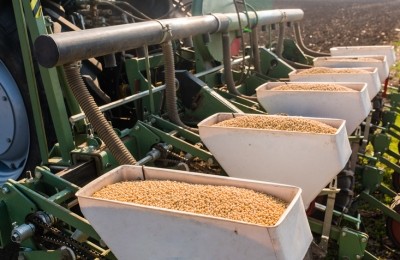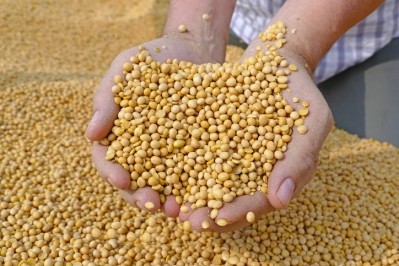USDA: Uncertainty, large crops drop prices for soybeans and corn

Overall, production expectations for 2018/19 forecast an increase for some US feed crops including corn, sorghum and soybeans, said the US Department of Agriculture (USDA) in Friday’s World Agriculture Supply and Demand Estimates (WASDE) report. However, US wheat production dropped slightly and saw projected exports increase.
In corn production there was an anticipation that yields would increase, which was supported by USDA information, said Frayne Olson, professor in agribusiness and applied economics with North Dakota State University. “There wasn’t a tremendous amount of shock,” he added.
“On the soybean side – that’s where everything is falling apart on us,” he said. “There is a tremendous amount of uncertainty and [yield] came up higher than expected – the biggest shock in the report was the yield forecast for beans.”
Corn considerations
The outlook for US corn in the coming marketing year calls for larger supplies more feed and residual use, larger ending stocks and more exports, the USDA said.
Overall corn production is forecast at 14.6bn bushels – based on a yield per acre of 178.4 bushels, the department said. The larger crop and an anticipated drop in price are expected to increase feed use.
There is still a portion of the growing season left, which could alter yields, said Olson.
There remain questions about trade and exports for corn, he said. Mexico is the US’s top corn market, but demand looks good at this point.
“Corn demands from an export side have been pretty reasonable,” he said.
Export predictions rose, reflecting increased competitiveness and the drop in competition from Brazil, the department said. However, supply is still set to grow faster than use and projected ending stocks have been increased to 1.7bn bushels.
Season average corn price has been dropped by $0.20 to a range of $3.10 to $4.10 a bushel, the department said.
The global production outlook anticipated a drop in corn production in the EU, only partly offset by production in Romania and Bulgaria, the USDA said. Corn production in Brazil also has been reduced based on predicted area to be planted for second-crop corn.
Zimbabwe, Ukraine, Serbia and Moldova are anticipated to see increased corn production, however, Zambia and South Africa are set to see smaller yields, the department said. Total ending stocks, however, have been raised.
Predictions for global trade in 2018/19 call for reductions in exports from Brazil, Zambia and South Africa that are only partially offset by additional exports for Serbia, Ukraine and Moldova, the department said. Corn import expectations have been increased for the EU.
Soybeans surprises
US oilseed production is forecast up 7.7m tons to 135.6m, said the USDA. Production for soybeans has been increased by 276m bushels based on yield.
Higher production will offset reduced beginning stocks, and overall supplies for 2018/19 are expected to a record 5.04bn bushels, a 5% increase from last month, the department said. Crush, exports and ending stocks have been increased by 15m, 20m and 205m bushels, respectively.
The USDA uses a sound methodology, but it can be a challenge to estimate soybean yields at this point in the growing season, added Olson. Weather can still influence production at this stage, although it currently appears to be favorable.
“The greatest uncertainty is still on the trade side – in particular for soybeans and the tariffs that China has placed on US soybeans,” he said. China is the largest market for US soybeans by about a factor of 10, he added.
Average prices for soybeans have been reduced by $0.35 from last month, and the range for soybean meal has been dropped to $295 to $335, said the USDA.
“If we can’t sell to China we’ll sell to somebody else – we’ll pick up some of the backfill – and that is true, there will be round-robin going on, and the Chinese will have to buy some beans from the US at a higher price,” said Olson. “But what I want farmers to think about is to separate the movement of beans versus what is the price for those sales to be completed – the volume of trade versus the pricing.”
The market has a way to get rid of product, he said. “If I was another country looking to buy beans I’m going to be a price-sensitive buyer – this is a buyers’ market now,” he added.
Additionally, there would be some lag in the market even if the tariffs were ended, he said. For producers in areas like North Dakota, who are dependent on the market with China the basis margin has widened and would take some time to recover.
Additionally, there may be challenges finding space to store the upcoming crop, he said.
“Because of the climate and the types of crops that we grow, we tend to have a lot of on-farm storage capacity,” he said. “It’s typical for a farmer to have enough storage for one year’s crop, but the bins are never empty – so when you think about the available space that you have – we’re going to be short.”
Changes to expectations for the 2017/18 crop include increased exports, higher crush and reduced ending stocks, the department said.
Globally, the oilseed supply for 2018/19 predicts increased production, exports, crush and larger stocks, said the department. Soybean, peanut and cottonseed crops have all been increased based on US production, however, the EU saw a drop in its rapeseed production.
The export forecast for 2018/19 has been raised to 182m tons and crush was increased to 501.8m tons, the department said. Reduced crush in China and the EU are expected to be offset by increased for Russia, the EU and Ukraine.
Another consideration of the response to the trade disruption between the US and China is how soybean producing countries in South America will respond, said Olson. There is an expectation that production will increase in Brazil and that producers in Argentina will see a price incentive to trade corn acres for soybeans.
Wheat and sorghum results
The wheat outlook for 2018/19 expects a reduction in supplies and stocks along with an increase in use, said the USDA.
Production was dropped to 1.887bn based on a drop in yield for winter and spring wheat, the department said. Use in food, however, is expected to increase to 970m bushels, which would be record use.
Wheat exports were increased by 50m bushels based on a drop in exportable supplies from the EU and other competitors, the department said. Ending stock forecasts were dropped to 935m bushels, down 15% from last year.
Season average farm prices was raised $0.10 at the midpoint for a range of $4.60 to $5.60, the department said.
World supplies of wheat were lowered by 7.1m tons, predominately based on production in the EU where continued drought has reduced production, the department said. However, Russia is anticipated to see an increase in wheat production.
Global trade in 2018/19 is anticipated to drop, based on a reduction in exports from the EU, only partially offset by growth in exports from Russia, the department said. “Russia is projected to remain the leading world wheat exporter for the second consecutive year,” it added.
There also is expected to be a drop for imports for several countries, the department said. World consumption is anticipated to be down based on the drop in feed use and ending stocks are forecast to be down about 5% from the record set last year.
US sorghum production is predicted to be higher as yields improved from earlier projections, the USDA said. Sorghum use also is anticipated to increase.












